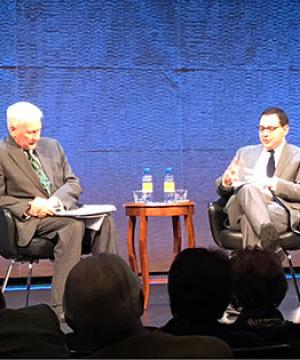The Reality of Presidential War Powers
One week after Congress held the first hearing in 41 years on the president’s authority to order the use of nuclear weapons, two of Columbia Law School’s leading scholars of war powers and the Constitution discussed what’s at stake before a large audience at the New-York Historical Society in Manhattan.
During the Nov. 21 event, Philip Bobbitt, the Herbert Wechsler Professor of Federal Jurisprudence, and Matthew Waxman, the Liviu Librescu Professor of Law, discussed war powers and the presidency, including a proposal by Waxman that would constrain the president’s authority to order a nuclear first strike.
The idea comes amid the prospect of a confrontation between North Korea and the United States. The Senate Foreign Relations Committee recently even examined the chain of command surrounding the use of nuclear weapons; that was the first time since 1976 Congress had visited the issue.
“Key advisers are going to be brought in 99% of the time, but I’m worried about that 1%, and I want to plan for it,” Waxman explained in response to a question from Bobbitt.
For his part, Bobbitt distinguished an imminent attack on the U.S. – a scenario that he noted would be detected by the “thousands of people” who monitor such threats in real time – from a scenario in which a president, on a whim, ordered an attack.
“I’m not convinced that it’s constitutional to insert the attorney general or secretary of defense,” said Bobbitt, who termed “fanciful” the prospect that the chain of command would carry out an order to launch an attack illegally.
Waxman, however, emphasized that the prospect of military officers refusing to carry out a launch order is dangerous, too. He argued that his proposal aims to simultaneously constrain as well as ensure the integrity of nuclear launch authority. These are low-probability threats, Waxman acknowledged, “but the magnitude is so great that we need to get it right.”
The reality of war powers
Though the Constitution entrusts the power to wage war to the president and Congress, the contours of that power have developed and evolved over time, noted Waxman, a chair of Columbia’s National Security Law Program. He has chronicled the development of an insight, first articulated by Charles Evans Hughes (Class of 1884) in a speech 100 years ago, that, as Hughes wrote, “the power to wage war is the power to wage war successfully.”
“The two people who have most influenced my thinking about constitutional war powers are Charles Evans Hughes and Philip Bobbitt,” said Waxman. The key insight, he explained, is that constitutional war powers can only be properly understood in the context of changes in American defense strategy.
Waxman outlined the shifts in war powers from the early days of the republic, when Congress controlled military activity abroad and the U.S. avoided alliances that might entangle it in conflicts, to World War II. That led to a series of such alliances (think NATO), the Korean War, which was fought without congressional authorization, and the War Powers Resolution, the 1973 law reasserting Congress’ authority vis-à-vis the president.
In practice, the resolution has been weakened, Waxman noted, largely “because Congress is kind of happy with a situation in which the president has discretion to use military force and Congress can... decide whether it wants to authorize it or not.”
A change since 9/11
The complicity of Congress could explain the use of military force against the Islamic State, observed Bobbitt. In the wake of the 9/11 attacks, Congress passed a law that authorizes the president to use military force against those who either committed or harbored those who committed the attacks. The Islamic State did not exist at the time, Bobbitt noted.
To say that law applies to the Islamic State “is a stretch that the Obama administration made and the Trump administration has continued,” noted Waxman, who held senior positions at the State Department, the Defense Department, and the National Security Council during the George W. Bush administration.
The authorization passed after 9/11 also authorizes the use of such lethal methods as drone strikes against extremist groups, the professors noted. Given an enemy that is dispersed geographically and that does not fight in uniform, Waxman said he “would defend legally and as a matter of policy targeted killing as part of the ongoing war against al-Qaida and its allies, but it’s a tool that has to be carefully regulated. I would like to see Congress play an oversight role.”
Though the framers described the Constitution as creating a government based on separation of powers, “that’s not really the system we have,” Bobbitt observed. “Our system is one of shared and linked powers,” he said. “There’s really nothing that a branch can do without getting the buy-in of at least one or perhaps both branches.”
Related reading
The Power to Wage War Successfully
Charles Evans Hughes and Constitutional War Powers
The Legal Underpinning of War since 9/11
###
Dec. 1, 2017
